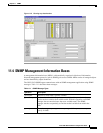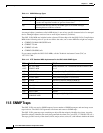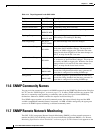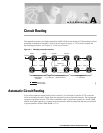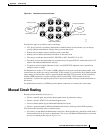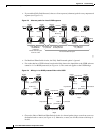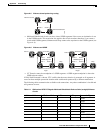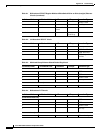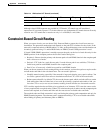
A-2
Cisco ONS 15454 Installation and Operations Guide
November 2001
Appendix A Circuit Routing
Automatic Circuit Routing
Circuit Routing Characteristics
The following list provides principles and charactistics of automatic circuit routing:
• Circuit routing tries to use the shortest path within the user-specified or network-specified
constraints. VT tunnels are preferable for VT circuits because VT tunnels are considered shortcuts
when CTC calculates a circuit path in path-protected mesh networks.
• If you do not choose Fully Path Protected during circuit creation, circuits may still contain protected
segments. Because circuit routing always selects the shortest path, one or more links and/or
segments may have some protection. CTC does not look at link protection while computing a path
for unprotected circuits.
• Circuit routing will not use links that are down. If you want all links to be considered for routing,
do not create circuits when a link is down.
• Circuit routing computes the shortest path when you add a new drop to an existing circuit. It tries to
find a shortest path from the new drop to any nodes on the existing circuit.
• If the network has a mixture of VT-capable nodes and nodes that are not VT capable, depending on
the route found, CTC will automatically force creation of a VT tunnel. Otherwise, CTC asks you
whether a VT tunnel is needed.
Bandwidth Allocation and Routing
Within a given network, CTC will route circuits on the shortest possible path between source and
destination based on the circuit attributes, such as protection and type. CTC will consider using a link
for the circuit only if the link meets the following requirements:
• The link has sufficient bandwidth to support the circuit
• The link does not change the protection characteristics of the path
• The link has the required time slots to enforce the same time slot restrictions for BLSR
If CTC cannot find a link that meets these requirements, it displays an error
The same logic applies to VT circuits on VT tunnels. Circuit routing typically favors VT tunnels
because, based on topology maintained by circuit routing, VT tunnels are shortcuts between a given
source and destination. If the VT tunnel in the route is full (no more bandwidth), CTC asks whether you
want to create an additional VT tunnel.
Secondary Sources and Drops
CTC supports secondary sources and drops. Secondary sources and drops typically interconnect two
“foreign” networks, as shown in Figure A-2. Traffic is protected while it goes through a network of ONS
15454s.




